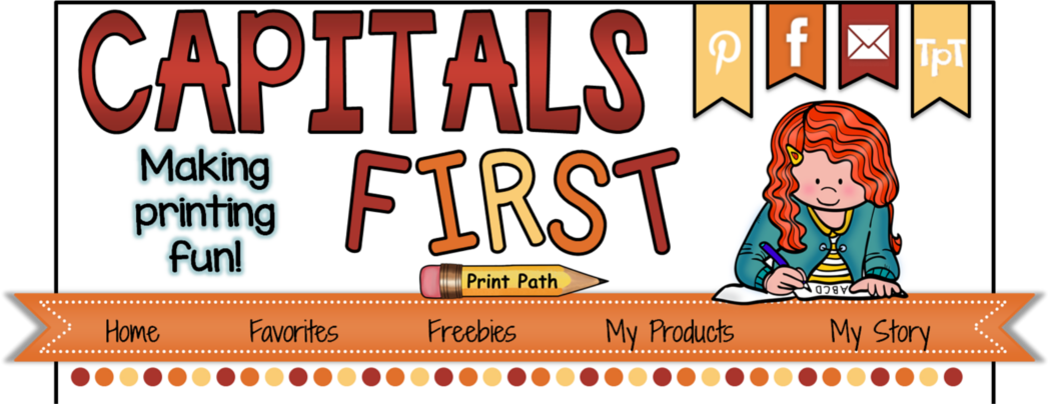Best Practices Behind Teaching Capitals Letters First
An unfortunate myth is that young children, 3 & 4 years old, should learn to write their name with an initial capital letter followed by lowercase, rather than all capitals. Research shows that to be incorrect and even detrimental, for several reasons.
First off, capital letters are made with just lines and curves so they are developmentally simpler, therefore children will have more success early on. The use of lines and curves to teach capital letter formation is seen in many places but was made popular by Jan Olson’s Handwriting Without Tears©. Teaching uppercase before lowercase affords the younger children the time they need to develop critical perceptual-motor concepts. Teaching capitals first teaches young children the essential top-to-bottom stroke and builds confidence that they can learn to print (Taras, Brennan, Gilbert, & Reed, 2011).

Secondly, when children are expected to form lowercase letters before they are ready to follow the complex movement patterns they form life-long illegible motor habits. (Asher, 2006; Sheffield, 1996) The more complex lowercase letters, which re-trace and shift directions, are sized differently, and put in differing spatial locations, are impossible for most preschool and even many beginning kindergarten children to execute. No matter how excellent the instruction, not all five-year-olds have the underlying spatial temporal perceptions or visual motor skills to support learning lowercase (Benbow, Hanft, & Marsh, 1992; Beery & Beery, 2010; Daly, Kelley, & Krauss 2003; Marr, Windsor, & Cermak, 2001).
Thirdly, quality explicit instruction of lowercase when children are ready, typically in the 5th year, results in children naturally switching to lowercase use. Moving through a developmental sequence is healthy and supports later development. Graham (1992; 2006) describes the difficult task teachers have in supporting children to un-learn incorrect and inefficient motor habits. It is the practicing of errors (i.e., incorrect motor learning) that adds to the child’s and teacher’s workload.
As an Occupational Therapist I know all too well about supporting children in unlearning ineffective handwriting habits. Preventing detrimental habits that have a strong negative impact on lifelong writing fluency is what I am all about. I am passionate about bringing fun, engaging, and developmentally appropriate tools to teachers, parents, and therapists.
 |
| I CAN MAKE MY NAME! |
This product is for preschool and beginning kindergarten children. It is packed with activities that are loads of fun and target essential fine motor and perceptual skills. "I CAN MAKE MY NAME" is all about giving kids 5 and under an easy and accessible way to construct their names with lines and curves.
For example, Pizzas curves and Pencil lines are cut [straight line cuts only] and are then glued onto a name frame.
Letter cards are used for sorting and partner tasks.
Posters can be used to help children look at and count the big and little lines in each letter.
Children then make their own nine page alphabet booklet where they count lines found in each letter.
I have found these skills to be pivotal for helping children to understand, remember, and then write letters.
I have found these skills to be pivotal for helping children to understand, remember, and then write letters.
In conclusion, just as we don’t expect toddlers to run until after they have mastered standing and walking, let’s not expect our preschool age children to write with lowercase until after they have mastered the handwriting basics of capitals!






I had no idea that it's better for little ones to form capital letters first, that's probably because I'm used to Middle School Children. Very helpful information is here. Thanks for sharing.
ReplyDeleteVery informative! I've worked with first grade, yet, not with kindergarten much. This is so helpful. Thank you.
ReplyDeleteThis makes so much sense! Thank you for sharing your knowledge about this subject!
ReplyDeleteGotta pass this on to teachers - and OTs - I know. Thanks for the great explanations.
ReplyDeleteSo interesting! You have such neat activities for having children work with the alphabet and printing! Very creative and thoughtful!
ReplyDeleteI love that you created this post! It's so easy to forget how young students begin writing with capital letters. Thank you for sharing this.
ReplyDeleteI never knew, but it makes so much sense... Thanks for sharing...
ReplyDeleteI found this site and read what you have to say and the research you state. I've also read the opposite research so I'm still confused. I have kids who have learned all uppercase to write, which is great, but breaking this habit is very hard. Any suggestions on moving from all caps to the mix? Thank you. I open to it all.
ReplyDeleteHello Mrs. D, Yes I too have seen children stuck writing capitals and having a hard time transitioning to lowercase. We have to consider why this child has not moved on: capitals are easier and they do not yet have the motor / perceptual skills to learn lowercase, they still need solid explicit instruction and then sufficient practice to learn lowercase, or they did not receive quality instruction when they were ready [typically 5 or 5 1/2 years and their motor habits are so over practiced that it is hard for them to change.
ReplyDeleteThanks so much for your comment, I know this can be a controversial subject! ~Thia